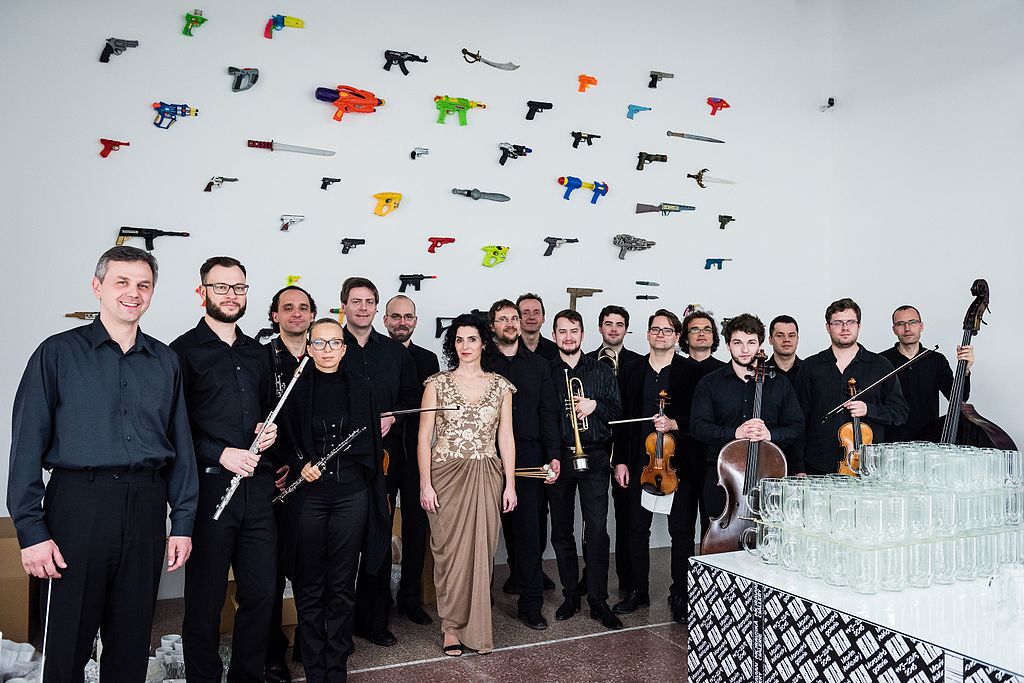
8. 10. 2020, 7 pm
Mahen Theater
| Conductor: | Pavel Šnajdr |
| Piano: | Pavel Zemen |
Václav Dobiáš – Nursery Rhymes for Nonet, with the film It Was the First of May by Thea Červenková (1919)
Leoš Janáček: Concertino JW VII/11 for piano, two violins, viola, clarinet, French horn and bassoon
Martin Smolka: Hats in the sky (together with the film Vormittagsspuk (Ghosts Before Breakfast)by Hans Richter (1928)
Igor Stravinsky (1882–1971): Pulcinella – suite for orchestra (1919/1920, rev. 1949)
The ballet Pulcinella by Igor Stravinsky is the exact opposite of Pierrot lunaire. The author had begun living outside Russia before World War I, mostly in France and Switzerland. In Paris he became close to Sergei Diaghilev, a promoter of Russian art and the organizer of the Russian Ballet, with which leading modern composers (Debussy, Satie, Poulenc, Prokofiev) and artists (Picasso, de Chirico, Braque, Matisse) cooperated. Stravinsky wrote his first ballet scores for Dagilev´s ensemble: The Firebird, Petrushka and The Rite of Spring, works of groundbreaking significance not only within the composer’s oeuvre but in terms of European music in general. The new, expressively aggressive sound of Stravinsky´s music of this period, where the rhythm is placed above melody and harmony, culminates in the ballet The Rite of Spring, whose premiere in 1913 ended in a legendary scandal. The sung ballet Pulcinella from 1919 was also made to order for Diaghilev´s Russian Ballet. However, there was a change in Stravinsky´s work at the end of the 1920s. Instead of unrestrainedly rhythmic “barbaric” scores, works of a more ‘chamber’ nature were born, marking a turn towards neoclassicism. The source for the ballet Pulcinella was the unpublished compositions of an Italian master from the 18th century, G. B. Pergolesi, which Diaghilev found during his stays in Italy. He had them copied, and presented them to Stravinsky for editing and the subsequent creation of music for the ballet. These were compositions from the archives of the Naples Conservatory: Act 3 of Il fratello inamorat from 1732, and fragments from the opera Il Flaminio. He also added melodic material from Triol sonatas for the violin and continuo, as well as some well-known arias.
Stravinsky was later accused of not treating the great composer with enough reverence and respect. However, according to Stravinsky respect always remains infertile and can never be a productive and creative element. The theme of the ballet was, again, determined by Diaghilev, who found a manuscript of Neapolitan theatre comedies from 1700 when in Naples and chose from among them the comedy Four Identical Pulcinellas, which featured characters from Italian commedie dell´arte. Leonid Mjasin took charge of the ballet’s choreography, and Pablo Picasso was the stage designer. The premiere of the ballet took place at the Paris Opera in 1920 and Stravinsky was extremely pleased with the final form of the performance: “The performance of Pulcinella was one of those – certainly precious – theatre moments where everything is interconnected and the sum of all the parts – the theme, music, choreography and design, creates a continuous, homogeneous whole.” Pulcinella remains one of the most beautiful works of neoclassicism to this day.
Concertino, which Janáček (1854–1928) himself sometimes called a ‘small piano concerto’, is the middle of three chamber compositions produced at the composer´s creative zenith (Youth, Concertino and Capriccio). Janáček was inspired to compose Concertino in 1924 by an excellent performance by the outstanding Czech pianist Jan Heřman, to whom the author subsequently dedicated the work. It was originally supposed to be a suite called Spring. Shortly before finishing the composition, Janáček wrote to his friend Kamila Stösslová from Hukvaldy: “… I’ve composed a piano concerto named “Spring” here. There is a cricket, flies, a roe-deer – a swift creek – and a person…” The title ‘Spring – Suite’ was replaced by the simple ‘Concertino’ in the end. The first performance took place on 16.2.1926 in Brno at a concert of the Moravian Composers´ Club, and the composition was a great success – the whole of it even had to be repeated. Concertino was equally successful at its first performance in Prague in the same year, after which the composition immediately flew almost all around the world. It was performed at (among other places) the festival of the International Society for Contemporary Music in Frankfurt in 1927.
At the request of the German specialized journal Pult und Taktstock, Janáček wrote a guide to the composition programme in 1927. In the first movement, a hedgehog is angry as the door to his den in an old linden tree was closed. The second movement is about a squirrel which used to jump around in the trees and but ended up dancing in a cage for the enjoyment of children. In the third movement, the staring eyes of owls and other critical denizens of the night are gazing at piano strings, and in the fourth movement it looks as if everyone is arguing over a coin – just like in a fairy tale.
Author: Jiří Zahrádka
